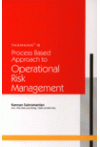- Author(s): Kannan Subramanian
- Publisher: Taxmann
- Edition: Ed 2015
- ISBN 13 9789350716250
- Approx. Pages 397 + contents
- Delivery Time 3-5 working days (within Kerala & South India) (Others 7-9 days)
.............................................................................................................................
Description
Over the last few years, several high profile operational incidents in banks across the world have created an awareness amongst the public that good governance is important for financial institutions. The stakeholders of the Banking Industry realise that the risk culture of a bank determines the safety of the savings of the customers, the institution, the industry and the financial markets. The Too Big to Fail' culture invited a lot of criticism. Industry experts recommended computing the bonus of senior management over a period rather than annually. Regulators implemented measures to improve the selling of complex products and several articles on the operational incidents have emphasised the need for better Know Your Employee programs in financial institutions.
Operational losses do occur in all types of financial institutions. Multi-national, Regional & domestic, Conventional, Islamic, Commercial and Investment banks face the challenges of operational efficiency and risk mitigation. Although banks appear to have recovered from the 2008 crisis, they continue to face the challenges of staying competitive and attaining the desired level of growth.
The motivation to implement operational risk management is a combination of the need to be competitive and compliant. This should be accomplished through the right dose of self-regulation and supervision.
Most banks are computing their operational risk capital by using either the Basic Indicator or the Standardised approach. The limitations of these approaches are well documented. Banks are aware that they can reduce operational costs, increase productivity and minimise risks by improving processes. Some banks are overwhelmed by the effort in moving to a more efficient operating model. This is probably out of the 'daily fire-fighting fatigue' rather than an output of an objective assessment of the effort to improve their operations.
.............................................................................................................................
Contents
Chapter 1 Introduction to Banking Products, Processes & Operational Risks
• Operational Risk
• An overview of the delivery of banking products and services
• Bank's Delivery Alignment
• Functional Overview of Delivery
• Front & Middle & Back Office Functions
• External Applications
• Lines of Business - Process Perspective of some Products & Services
• Retail Banking Products
• Corporate Banking Products
• Treasury Products
• Islamic Banking
• Approaches to computing Regulatory Capital for Operational Risk
• Basic Indicator Approach (BIA)
• Standardised Approach (TSA)
• Alternative Standardised Approach (ASA)
• Revised Standardised Approach (SA)
• Advanced Measurement Approach (AMA)
• Banking Processes and Operational risks
• Evolution of Banking Automation
• Operational Risk Management System (ORMS)
• Straight Through Processing (STP)
• Data dimensions at Process Level
• Process-based Risk & Control Monitoring
• Enterprise-wide Approach to Risk Management
Chapter 2 Operational Risk Incidents - Case Studies
• Case Studies
• Inference
• Correlation between risk factors
• Expected, Unexpected and Extreme Operational Loss
Chapter 3 Operating Model - Design, Build, Operate & Optimise
• Creating an Operating Model based on Processes
• Design
• Build the Operating Model
• Operate
• Model Optimisation
• Tools for building Operational Efficiency
• Business Process Management Suite (B.P.M.S.)
• Information Technology Governance (I.T.G.)
• Advanced Analytics
Chapter 4 Tools, Operational Risk Data & Target Operating Model
• Chapter 2 Risk Incidents - Data Gathering & ORM Tools
• Target Operating Model
• Gap Identification
• Gap Resolution
• Tools for improving Operational Efficiency - Twenty Case studies
Chapter 5 Process-Based Risk & Control Monitoring
• Salient Features of Advanced Measurement Approach
• Tools for building and using ORMF and ORMS
• Risk & Control Monitoring, Operational Risk Data Gathering
• Bank Level Non-technical Examples
• Bank Level - Technology
Chapter 6 Process-Based Risk & Control Monitoring, Data Management
• Risk & Control Monitoring, Operational Risk Data Gathering
• Front Office
• Middle Office
• Back Office
• Operational Risk Data & Process Maturity
• Data Points on Regulatory Capital
Chapter 7 Process-Based Operational Risk Management and Banking Supervision
• It Governance Model Maturity
• Operating Model Maturity
• Banking Supervision
• Emerging Operational Risk Management Issues
.............................................................................................................................
Author Details
Kannan has more than 26 years of experience in providing banking solutions across the globe. After qualifying as a Chartered Accountant n India, he pursued a career in the banking solutions industry. Kannan has worked for Standard Chartered Bank and with several leading banking solution vendors, including Algorithmics. He is experienced in Conventional and Islamic Banking. He has an exposure to Retail, Wholesale, Treasury and Risk Management functions. Kannan has effectively leveraged his accounting & banking background with systems skills. He is also an Associate in Islamic Finance from INCEIF, Malaysia, a member of the Association of Certified Anti-money Laundering Specialists and a Non-practising member of the Information Systems Audit & Control Association.
.............................................................................................................................

